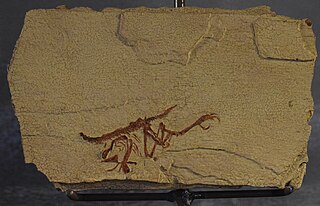
Iberomesornis is a monotypic genus of enantiornithine bird of the Cretaceous of Spain.

Pelecanimimus is an extinct genus of basal ("primitive") ornithomimosaurian dinosaur from the Early Cretaceous of Spain. It is notable for possessing more teeth than any other member of the Ornithomimosauria, most of which were toothless.

Rhabdodon is a genus of ornithopod dinosaur that lived in Europe approximately 70-66 million years ago in the Late Cretaceous. It is similar in build to a very robust "hypsilophodont", though all modern phylogenetic analyses find this to be an unnatural grouping, and Rhabdodon to be a basal member of Iguanodontia. It was large amongst its relatives, measuring 4 m (13 ft) long and weighing 250 kg (550 lb), with some specimens possibly reaching up to 6 m (20 ft) long.

Mantellisaurus is a genus of iguanodontian dinosaur that lived in the Barremian and early Aptian ages of the Early Cretaceous Period of Europe. Its remains are known from Belgium (Bernissart), England, Spain and Germany. The type and only species is M. atherfieldensis. Formerly known as Iguanodon atherfieldensis, the new genus Mantellisaurus was erected for the species by Gregory Paul in 2007. According to Paul, Mantellisaurus was more lightly built than Iguanodon and more closely related to Ouranosaurus, making Iguanodon in its traditional sense paraphyletic. It is known from many complete and almost complete skeletons. The genus name honours Gideon Mantell, the discoverer of Iguanodon.
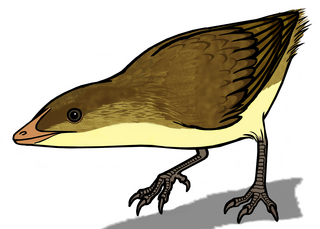
Eoalulavis is a monotypic genus of enantiornithean bird that lived during the Barremian, in the Lower Cretaceous around 125 million years ago. The only known species is Eoalulavis hoyasi.
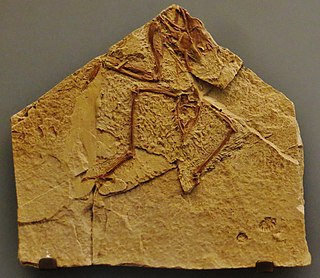
Concornis is a genus of enantiornithean birds which lived during the early Cretaceous period, in the late Barremian age about 125 million years ago. Its remains are known from the Calizas de La Huérgina Formation at Las Hoyas, Cuenca province, Spain. The single known species, Concornis lacustris, was described from the remains of one fairly complete individual skeleton.

The Urbión Group is a geological group in Castile and León and La Rioja, Spain whose strata date back to the Early Cretaceous (late Hauterivian to late Barremian. The formations of the group comprise a sequence of brown limestones in a matrix of black silt, sandstones, claystones and conglomerates deposited under terrestrial conditions, in alluvial fan and fluvial environments.

The Enciso Group is a geological formation in La Rioja, Spain whose strata date back to the Early Cretaceous.

The La Huérguina Formation is a geological formation in Spain whose strata date back to the Barremian stage of the Early Cretaceous. Las Hoyas is a Konservat-Lagerstätte within the formation, located near the city of Cuenca, Spain. The site is mostly known for its exquisitely preserved dinosaurs, especially enantiornithines. The lithology of the formation mostly consists of lacustrine limestone deposited in a freshwater wetland environment.
The Arcillas de Morella Formation is a geological formation in Spain whose strata date back to the Barremian stage of the Early Cretaceous. Dinosaur remains are among the fossils that have been recovered from the formation.
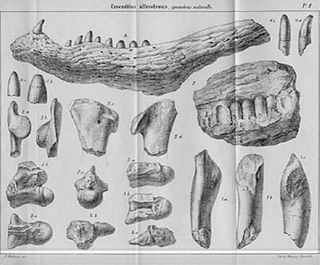
Massaliasuchus is an extinct monospecific genus of allodaposuchid eusuchian crocodyliform that is known from fossils found in Santonian–Campanian-age Upper Cretaceous rocks of southeastern France.

Musturzabalsuchus is an extinct monospecific genus of allodaposuchid eusuchian crocodyliform. The type and only species is Musturzabalsuchus buffetauti.
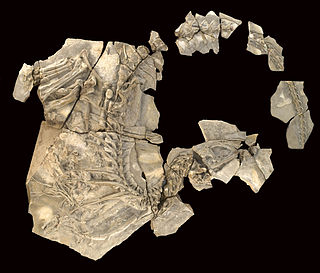
Concavenator is an extinct carcharodontosaurid theropod dinosaur that lived approximately 130 million years ago during the Early Cretaceous period. The type species is C. corcovatus. Concavenator corcovatus means "Cuenca hunter with a hump". The fossil was discovered in the Las Hoyas fossil site of Spain by paleontologists José Luis Sanz, Francisco Ortega, and Fernando Escaso from the Autonomous University of Madrid and the National University of Distance Education.

Hoyasemys is an extinct genus of basal eucryptodiran freshwater turtle from Lower Cretaceous deposits of Cuenca Province, Spain. It is known from the holotype MCCM-LH 84, a nearly complete and articulated skeleton including the skull. It was found in the 1980s from the Las Hoyas site of the Calizas de La Huérguina Formation, near La Cierva township, Spain. It was first named by Adán Pérez-García, Marcelo S. de la Fuente and Francisco Ortega in 2011 and the type species is Hoyasemys jimenezi. The generic name is derived from the word Hoyas meaning "the basin" in Spanish, which refers to the Las Hoyas fossil site it was found in, and emys. The specific name honors Dr. Emiliano Jiménez Fuentes.

Gideonmantellia is an extinct genus of basal ornithopod dinosaur known from the Early Cretaceous Camarillas Formation of Galve, Province of Teruel, Spain. It contains a single species, Gideonmantellia amosanjuanae.
Lohuecotitan is an extinct genus of titanosaurian sauropod dinosaur which lived during the Late Cretaceous in Spain. The only species known in the genus is Lohuecotitan pandafilandi, described and named in 2016.

Lohuecosuchus is an extinct genus of allodaposuchid eusuchian crocodylomorph that lived during the Late Cretaceous in what is now Spain and southern France.

Vallibonavenatrix is a genus of spinosaurid dinosaur from the Early Cretaceous (Barremian) Arcillas de Morella Formation of Castellón, Spain. The type and only species is Vallibonavenatrix cani, known from a partial skeleton.
Protathlitis is a genus of spinosaurid dinosaur from the Early Cretaceous (Barremian) Arcillas de Morella Formation of Castellón, Spain. The type and only species is Protathlitis cinctorrensis, known from a partial skeleton. It was a basal member of the Baryonychinae. Its discovery, as well as those of the spinosaurids Camarillasaurus, Iberospinus, Riojavenatrix, and the contemporary Vallibonavenatrix shows that the Iberian Peninsula held a diverse assemblage of spinosaurids during the Early Cretaceous.

Garumbatitan is an extinct genus of somphospondylan sauropod dinosaur from the Cretaceous Arcillas de Morella Formation of Spain. The genus contains a single species, G. morellensis, known from multiple partial skeletons.



















